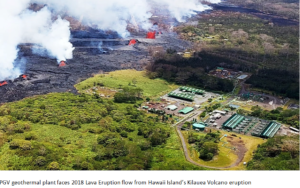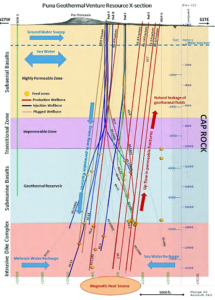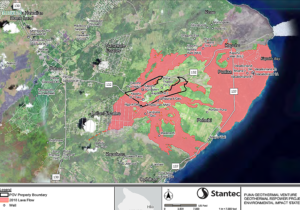Geothermal (story update); the good, bad, and the ugly
Updated story supplement; originally Published June 2, 2023
In a recent announcement, the Department of Hawaiian Home Lands (DHHL) voted to investigate the potential development of geothermal energy sources on their lands. The DHHL decision was strongly influenced by Mike Kaleikini of Puna Geothermal Venture (PGV), a clear conflict of interest.
Part of the PGV argument is that DHHL would benefit from geothermal royalty payments, creating a new source of income for DHHL.
Geothermal development is inherently slow and high risk in terms of any potential success and return-on-investment. You really don’t know if you have a viable thermal resource until you actually spend money and drill research wells. PGV history of years of drilling occurred which has occured on on the East Rift Zone of Kilauea had been without success before a discrete pocket of fluids was found and Ormat Technologies was able to then step in and build a power plant. With the eruption of 2018, magma has since moved in at depth dramatically impacting the overall effectiveness of the geothermal resource.
Carving out a piece of the energy pie and reserving it for geothermal that may or may not happen after spending a whole lot of money on drilling wells hurts all consumers.
The current Stage 3 energy solicitations for renewables on Hawaii Island are constrained by giving a big reservation to future geothermal. Cheaper and cleaner energy projects aren’t given a chance to compete and get us off fossil fuels sooner than later. Central power plants like PGV also have “must run” contracts that force curtailments of cheaper and cleaner renewable alternatives which acts as a double whammy on ratepayers.
Solar and wind farms go in much faster and could also be sources of lease rent revenue for DHHL. Why wait around for a resource that might not never be viable? This is particularly true for smaller CBRE or community based renewable energy projects that are on a fast track process to deployment. With low risk, proven, clean energy options, as with solar plus storage, these projects would especially help Hawaiian families who are low to moderate income and would directly benefit from reduced energy bills — it’s a win-win with both revenue to DHHL and targeted to provide relief which geothermal cannot guarantee.
Hawaii has declared a Climate Emergency and public trust resources like our nearshore coastal waters are threatened. This threatens Hawaiians that rely on those resources for subsistence. We need to act fast and get off power plants that emit greenhouse gases and otherwise negatively impact Hawaii’s unique environment.
The recent fires on Maui and the Big Island have made it clear that climate change threatens us all. Droughts threaten our water supply. The future of our planet us at stake, so why would we wait around and put off moving ahead on wind and solar projects? Why give special treatment to geothermal developments that may or may not happen and that cost more?
Previously published June 2, 2023

Puna Geothermal Venture (PGV) manages Hawaii’s longest operating and only geothermal power plant, temporarily closed in 2018 after a near miss from the lava flows from a major eruption by Hawaii’s most active volcano, Kilauea. Prior to its closing, Hawaiian Electric reported that PGV supplied and fulfilled 31 percent of Hawaii Island’s electricity demand.
Geothermal energy has only a modest representation in Hawaii’s renewable energy portfolio, but strong support by backers of the energy source. In 2018, according to the state energy office, prior to PGV’s closure it supplied less than 3 percent of Hawaii’s total electricity production. At the time, future plans called for modest increases in geothermal, while solar remains the dominant clean energy source.
For decades, Hawaii’s sole geothermal power plant has been parked on top of an active rift zone of the most active volcano in the country. For PGV, their luck ran out with the 2018 eruption where a river of molten lava threatened its existence. Since then, PGV has struggled to restore power production in spite of extensive and on-going drilling. As of June 2023, PGV has still not fulfilled their power commitment (contract) levels to Hawaiian Electric (HELCO), and it has become increasingly clear that intruded magma at depth has impacted the discrete pocket of fluids that they rely on for power production.
While we can’t see down a mile into the ground, the mere fact that production and revenues remain down for PGV pretty much tells the whole story. The very notion that they might some day get up to 60 MW output (based their 2022 power provisioning negotiations with HELCO) seems highly speculative, and frankly stands in the way of meeting our renewable energy goals using other more reliable and readily available sources; solar, wind, storage energy options that don’t carry the geologic risk. It reserves a big piece of the energy pie for them.
During the time when PGV was down, utility power was supplemented from fossil fuel generation, a big step backward for the state, and Hawaii Island more specifically. The State of Hawaii has declared a climate emergency and set decarbonization targets that require faster action than just the 2045 goal of 100% renewables. We have choices on the Big Island other than geothermal like more wind and solar. Recently, Waikoloa Solar came onto the grid with 30 MW of production plus battery storage at under 10 cents per kWh – a substantial energy savings back to ratepayers.
The Social Costs of Geothermal, and …Resistance is Futile
Prior to the Kilauea eruption of 2018, Hawaii state energy office stated that 17 percent of the of Hawaii Island’s electricity was produced by the Puna Geothermal Venture (PGV) plant operations on the island.
Since the 2018 Kilauea eruption and PGV’s closure, Hawaiian Electric said it has used a mix of fossil fuels, solar, wind and hydropower to generate power without any issues or outages as the result of the PGV geothermal suspension of power production.
 The PGV power plant, Puna Geothermal Venture, began commercial operation 25 years ago despite objections from local residents who are concerned by the company’s non-stop geothermal drilling and operations. The release of geothermal fluids and toxic hydrogen sulfide emissions, direct side effects of the company’s operations are key concerns of nearby residents. Recently, HELCO has proposed increasing the capacity charges for PGV under the new contract which will impact savings projections as they no longer receive the avoided cost of oil. Consumers islandwide would be impacted.
The PGV power plant, Puna Geothermal Venture, began commercial operation 25 years ago despite objections from local residents who are concerned by the company’s non-stop geothermal drilling and operations. The release of geothermal fluids and toxic hydrogen sulfide emissions, direct side effects of the company’s operations are key concerns of nearby residents. Recently, HELCO has proposed increasing the capacity charges for PGV under the new contract which will impact savings projections as they no longer receive the avoided cost of oil. Consumers islandwide would be impacted.
On May 3, 2018 earth fissures opened inside and around the Leilani Estates subdivision near the PGV plant, following hundreds of earthquakes over the first two days of May. The threat of possible toxic hydrogen sulfide gas releases and explosions at the geothermal power facility led the County to order preemptive well shutdowns and moving the storage of about 60,000 gallons of highly flammable and toxic pentane, a chemical used in the heat exchanger process.
Shortly after the 2018 volcanic eruption of Kilauea covered a large area of Puna, former State Sen. Russell Ruderman, admitted at the time that he has been protesting geothermal energy for 30 years. He described the eruption and impact on geothermal plant operations as a “triple whammy” of issues associated with PGV; 1) the toxicity of the geothermal steam, 2) the geologic instability of the area where the plant resides, and 3) the proximity to residents of the area. “Even if you don’t know anything more than that, it’s obviously not the place to put any critical infrastructure,” Ruderman said.
The main community complaints to PGV energy operations are in a word “drilling”. What at times are around-the-clock drilling operations by PGV are for the PGV’s residential neighbors more than a just an occasional nuisance; noise, toxic gas emissions to name just two, are ongoing threats to the local community.
For PGV the problem of costly drilling operations can be summed up in two words; geothermal brine. Geothermal brine was the power source for PGV, which results in a variety of well problems including geothermal well and line plugging, reduced steam flow, and reduced power generation capacity. Altogether, the operation requires repeated drilling of new replacement wells.
According the company, plant operations resumed at a highly reduced level in November 2020 and to date power production remains far below minimum power production requirements under its HELCO (utility) power agreement.
Last year, PGV announced that it expected a power output goal of 46 MW in Phase 1 and then to 60 MW in Phase 2, to be achieved in power output to the grid by replacing 12 operating power-generating units with as many as four upgraded power-generating units, operating on the existing grounds of the current facility. In the meantime, PGV at community meetings has indicated output at or under 25 MW.
On the road to fulfilling PGV’s current plans for operational expansion that will result in higher power supply (capacity) agreement with the utility, is that the company must file an Environmental Impact Statement (EIS) with public agency stakeholders. The EIS serves as a public disclosure document with Hawaii County serving as the official accepting agency, and with the state Public Utility Commission oversight. The PUC has already given PGV its preliminary approval to the company’s expansion plans in the form of a new Power Purchase Agreement with HELCO, and one that industry observers believe will be rubber stamped by the stakeholders advancing the company’s 2023 expansion plans.
Show Me the Money
 Even today, the East Rift Zone is seeing inflation as new magma is intruded below the surface. A very dynamic situation. Something PGV’s investors will need to consider as drilling is neither cheap nor results guaranteed. Investors will be needed to spend even more on PGV to replace existing power generation much less the funds for expansion. More on drilling, too. This uncertainty and risk goes beyond just nervous investors as ratepayers are paying for expensive fossil fuel generation in the meantime.
Even today, the East Rift Zone is seeing inflation as new magma is intruded below the surface. A very dynamic situation. Something PGV’s investors will need to consider as drilling is neither cheap nor results guaranteed. Investors will be needed to spend even more on PGV to replace existing power generation much less the funds for expansion. More on drilling, too. This uncertainty and risk goes beyond just nervous investors as ratepayers are paying for expensive fossil fuel generation in the meantime.
PGV is currently receiving the avoided cost of oil and is in contract renegotiation talks, but HELCO is proposing higher capacity charges to payback drilling costs. With no end in sight on the need for even more drilling, this changes the economics. Geothermal becomes even less competitive. The new PGV contract has a “must run” provision that forces the grid (and ratepayers) to take their less than clean power over potentially cheaper and cleaner sources through what the industry calls “curtailment”. Curtailment impacts lower cost and clean energy sources solar and wind to have reduced revenues causing higher bid prices on new contracts which, of course, also gets passed onto ratepayers. A double whammy for Hawaii Island residents and commerce.
One of the utility arguments for calling geothermal energy “firm” power ignores the impact of an active volcano. It also ignores the reality that production has still not been fully restored to pre-eruption levels or that more activity could take them out again at any time, and an increase in production levels (capacity) as a part of new contract with the utility seem unreliable at best. Not exactly a definition of “firm” or reliable power.
Back to the Future
HELCO likes PGV because it fits the old central power plant model where they get revenue from transmission and distribution costs that get passed on to ratepayers. PGV, due to it’s remote location has higher line losses or reduced efficiency that also get passed on to ratepayers. Decentralized power generation is more cost effective.
The whole history of geothermal energy development should tell us that the risk is real and that many of the wells drilled historically were capped as non-productive.
The state’s geothermal resource maps are very misleading at best, or worse fully unsubstantiated. The massive 250 MW Kahaualea Geothermal project that was supposed to solve all of Hawaii’s greater energy problems with a deep water cable to Oahu was interrupted before it began with a 30 year long volcanic eruption.
We should be learning something here. Planning for and betting on a major source of power generation for Hawaii in the form of geothermal is not welcome or wise. The geothermal booster club on Oahu needs to fly over to the Big Island to better understand the geology. Flying in a helicopter with scientists back in 2018 over PGV with a raging river of lava on one side and fountaining ground cracks on the other should have been a wake-up call, but somehow geothermal boosters just see it as a temporary setback and don’t see it as a continuing threat.




Great rundown on the sorry history, and now, poor prognosis.
When will the PGV investors begin seeing diminishing returns?
PGV’s 1987 Environmental Impact Statement failed to mention the cumulative effects of one geothermal well, much less 22, which is the number they are on today drilling nearly a well a year for 30+ years. If you google “geothermal induced seismicity” you will get millions of scholarly hits, but if you search that term in the University of Hawaii Geothermal Program you get ZERO hits. University of Hawaii Professor Don Thomas says PGV has no impact when they injected over 1.3 million gallons of cold water and then salt water into their hot and bending production wells as they waited for FEMA to fly in their experts, quench pump to blow the smithereens out of Puna, salt to make the water erupt just like it does at the ocean…
Puna Geothermal has never met their contracted megawatts
They should have gone bankrupt
How they still around?
Mineral rights
Billions in profit while poisoning what feeds us
Geothermal is not green
Unless you mean the green in their bank
Time to shut this toxic plant now
Poisoning water air and our food